You'll find that sake's unique chemical properties make it a powerful traditional Japanese preservative method dating back over 2,500 years. The 17-20% alcohol content and lactic acid naturally inhibit harmful bacteria, while the koji enzymes enhance both preservation and flavor. To use sake for food preservation, you'll want to maintain storage temperatures between 5-15°C and protect items from light exposure. This preservation technique works especially well with fish, meats, and vegetables, creating rich umami flavors through the aging process. Discovering the ancient Japanese art of sake preservation opens up a world of traditional food storage wisdom.
Ancient Sake Preservation Origins
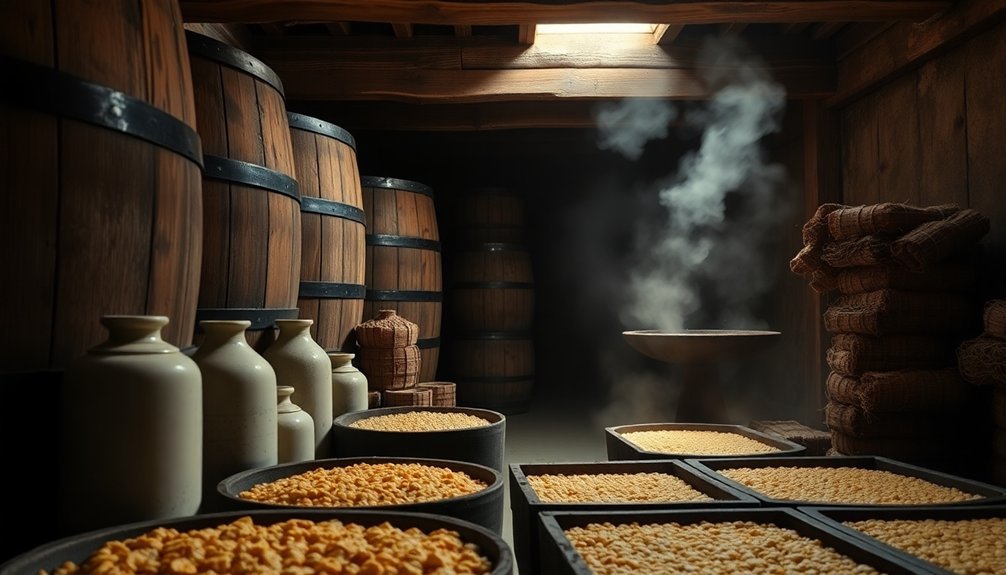
During Japan's Yayoi period roughly 2,500 years ago, sake emerged alongside the rise of rice cultivation, though some theories suggest its existence even earlier in the Jomon period.
You'll find the earliest written records of sake dating back to the third century, primarily in western regions like Kinki and Kyushu, where Chinese brewing methods had likely been introduced.
Early preservation methods were quite different from what you'd recognize today. The fascinating "Kuchikami-no-Sake" method involved shrine maidens chewing rice to create enzymes from saliva for fermentation.
During the Heian period, temples and shrines produced "Soubou-Shu," which helped establish more structured preservation techniques. The sacred beverage was primarily used in Shinto rituals during this time.
You'll notice significant advancements in preservation during the medieval period, particularly with the development of pasteurization methods documented in "Sake Journal."
The Edo period brought even more sophisticated preservation techniques, including "Kan-Zukuri" (cold brewing) and "Hiire-ho" (burning method).
These innovations weren't just about taste – they were vital for maintaining sake's quality during storage and transport, especially as production expanded to meet growing demand from commoners.
Sake Storage Equipment
Today's sake storage combines high-tech equipment like the SAKE CELLAR® with classic preservation methods, giving you precise control over temperature settings from -5℃ to 20℃.
Modern storage solutions like SAKE CELLAR® offer flexible bottle capacity with space for up to 60 large or 104 medium-sized bottles.
You'll find storage vessels ranging from traditional ceramic containers to modern vacuum-sealed bottles, each designed to minimize oxidation and preserve sake's distinct characteristics.
Whether you're using a sophisticated temperature-controlled cellar or a basic refrigerator, you'll need to maintain consistent cool temperatures and protect your sake from light exposure for ideal preservation.
Storage Vessels and Materials
From ancient cedar barrels to modern stainless steel tanks, sake storage vessels reflect both Japan's rich brewing traditions and its contemporary innovations. The traditional cedar barrels, bound with bamboo ropes, don't just store sake – they infuse it with distinct flavors and remain essential for ceremonial purposes.
While these vessels honor Japan's brewing heritage, they've largely given way to stainless steel tanks in commercial production. Traditional kazaridaru barrels are prominently displayed at Shinto shrine entrances as decorative elements during festivals. You'll find that modern storage methods prioritize consistency and purity, with stainless steel tanks becoming the industry standard.
However, when it comes to serving vessels, you've got several options that can enhance your sake experience. Pottery and ceramic vessels will soften the flavor and work well with yamahai and junmai sake, while glass containers are perfect for showcasing the delicate notes of ginjo and daiginjo varieties.
For serving, you can choose from various traditional vessels: o-choko cups for formal settings, tokkuri carafes for controlled pouring, or guinomi cups for casual drinking. Each material impacts the sake differently – tin softens acidity, metal maintains coldness, and lacquerware offers versatility across different sake styles.
Temperature Control Equipment
Precision engineering defines modern sake temperature control equipment, which combines traditional warming methods with advanced technology.
You'll find these machines use a gentle warming system where warm water surrounds glass tubes, heating your sake indirectly between 45-65°C while preserving its delicate flavors and aromas.
The equipment's core components include water level indicators, temperature control buttons, and adaptable couplers that connect to various sake containers.
You'll notice the adjustable tray beneath the spout allows for flexible positioning of serving vessels, while the level sensor provides convenient auto-stop functionality.
To operate the system, you'll need to add water through the top opening, attach your sake container using the appropriate coupler, and select your desired temperature.
The machine draws sake through the glass tubes, warming it gradually before dispensing it into your serving flask.
You won't have to worry about direct heat damaging your sake's quality or clarity.
While these machines aren't typically NSF or UL approved for Japanese models, they're built to last with proper maintenance.
You can expect a lifespan of over ten years if you maintain regular cleaning routines and proper care.
Rice Wine Food Curing
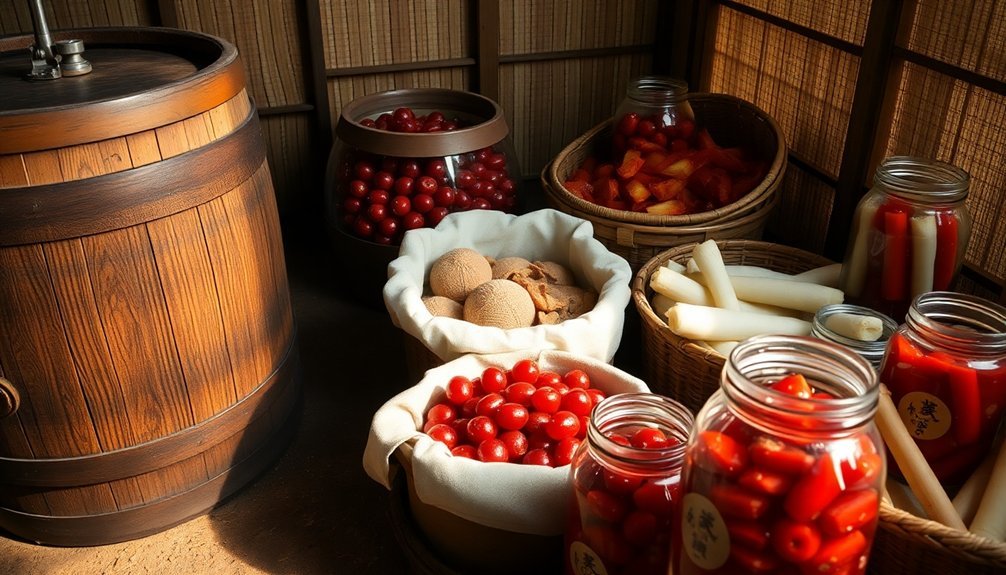
Traditional sake production techniques have proven invaluable in food preservation methods throughout Japanese culinary history. When you're curing foods with sake, you'll find that its 17-20% alcohol content and unique chemical compounds create an effective preservation environment. The lactic acid produced during the sokujo-moto process, combined with the alcohol content, helps inhibit harmful bacteria growth in foods.
You'll want to use sake that's been properly pasteurized at 60-65°C, as this guarantees all unwanted microorganisms have been eliminated. The amino acids and peptides produced during koji fermentation contribute to both preservation and flavor enhancement of cured foods.
When you're storing sake-cured foods, you should follow similar principles used in sake storage – keep them in cool, dark places to maintain their quality.
For the best results, you'll need sake that's been filtered using traditional cloth methods, as this maintains the beneficial compounds while removing unwanted particles. The enzymes from koji, though partially deactivated during pasteurization, still contribute to the curing process by breaking down proteins in foods, creating complex flavors while extending shelf life.
Temperature Control Methods
The art of temperature control stands at the heart of sake excellence, building upon the same careful attention to detail used in sake-based food preservation.
You'll need to master different temperature ranges to bring out the best in each sake variety, from cold-served ginjo-shu at 5-10°C to warm, rich varieties at 45-50°C.
When heating sake, you'll want to use the bain-marie method. Place your tokkuri in hot water that's been removed from heat, making sure the water covers about two-thirds of the vessel.
This technique guarantees even heating and helps release the sake's complex aromas and flavors.
For storage, you'll find that maintaining temperatures between 5-15°C in a dark place is essential.
You'll need to be especially careful with ginjo and daiginjo varieties, as they're particularly temperature-sensitive.
If you're storing namazake, keep it below 5°C to preserve its unpasteurized characteristics.
Once you've opened a bottle, you'll want to cap it tightly and refrigerate it.
While sake doesn't oxidize quickly, proper temperature control after opening will help maintain its quality for several weeks, letting you enjoy its nuanced flavors longer.
Light Protection Techniques
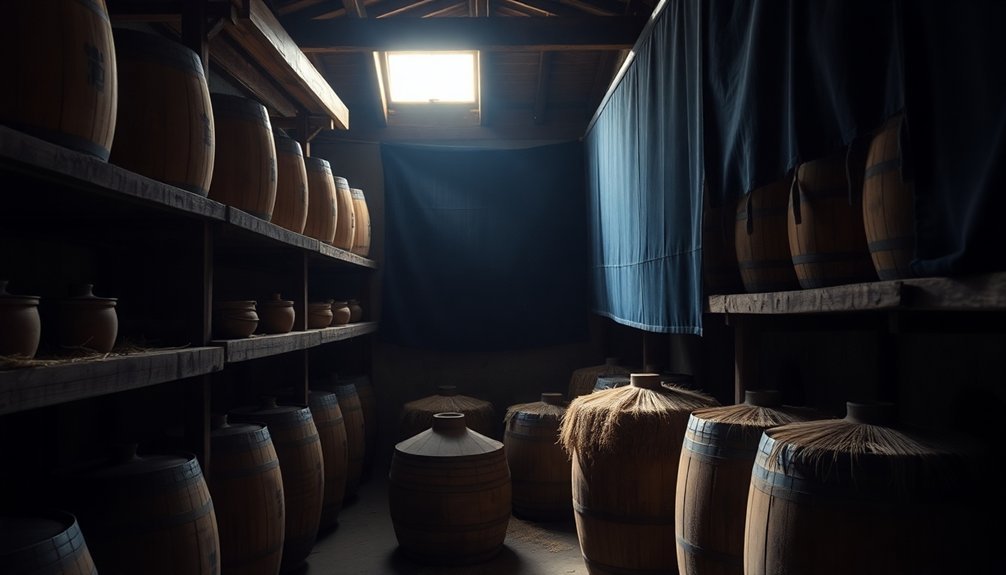
Consistently protecting sake from light exposure proves just as crucial as temperature control in preserving its delicate characteristics.
UV rays from both sunlight and fluorescent lighting can greatly damage sake's taste, aroma, and color. You'll find that brown and green bottles are specifically chosen for their superior ability to block harmful light transmission, particularly in the UV spectrum of 400nm or less.
For ideal light protection, you'll want to implement these essential techniques:
- Store your sake in a dedicated wine fridge or dark cupboard, away from any direct light sources.
- Use UV-resistant bottles, preferring brown or green glass over clear options.
- Apply UV-cut film to windows near your storage area, or wrap bottles in protective paper.
- Replace standard lighting with non-UV LED lights in your storage space.
If you can't access a specialized storage solution, you'll need to keep your sake in the darkest, coolest area of your home.
Don't overlook the importance of protecting sake glasses from light exposure, as even brief exposure during serving can impact the drink's quality.
The combination of proper bottle selection and thoughtful storage placement creates an effective defense against light-induced deterioration.
Sake Fermentation Benefits
During sake fermentation, you'll find that the acidic conditions naturally prevent harmful microbial growth, making the process inherently safer than many other fermented beverages.
The combination of koji fungi and yeast creates powerful enzymes that break down rice starches while simultaneously preserving the liquid through natural biochemical barriers.
These preservation qualities work together with the rice enzymes to create a stable environment that maintains sake's freshness throughout the fermentation period.
Microbial Growth Prevention Process
Mastering microbial control in sake fermentation yields significant benefits for both quality and consistency.
You'll find that the process relies heavily on both traditional and modern methods to prevent unwanted microbial growth while promoting beneficial microorganisms. The kimoto and sokujomoto methods serve as the foundation, with lactic acid bacteria playing a vital role in creating an environment that favors proper fermentation.
- Maintain strict temperature control at 140°F during pasteurization to eliminate unwanted microorganisms and remove excess CO2.
- Use proper racking techniques and fining agents like bentonite to remove particulates that could harbor contaminating microbes.
- Store sake in cool, dark conditions to prevent post-bottling microbial growth.
- Guarantee thorough sanitization of all bottling equipment and proper sealing to maintain sterility.
In the secondary fermentation phase, you'll want to monitor the remaining yeast activity as it cleans up lingering compounds.
The interaction between sake yeast and kuratsuki bacteria must be carefully managed, as ethanol levels will naturally help control bacterial growth.
Remember that external environmental factors can introduce adventitious microbes, so maintaining clean equipment and proper storage conditions is essential for preventing contamination throughout the process.
Preservation Through Rice Enzymes
Beyond microbial control, the power of rice enzymes stands at the heart of sake's preservation and fermentation success. When you're making sake, the key lies in how koji (Aspergillus oryzae) transforms steamed rice through its powerful enzymes, particularly α-amylase.
These enzymes systematically break down starches and proteins, creating an environment that's naturally resistant to spoilage.
You'll find that the preservation process begins with carefully selected sake rice, which is polished to remove unwanted proteins and lipids. The koji's enzymes then convert the remaining pure starch into sugar, enabling yeast to produce high alcohol content – typically around 20% ABV.
This elevated alcohol level serves as a natural preservative.
The process works best when you maintain specific temperature and humidity conditions. At cool temperatures (45-50°F), the enzymes operate effectively, creating a controlled environment that prevents unwanted bacterial growth while promoting beneficial fermentation.
Through this dual fermentation process, where saccharification and alcohol production occur simultaneously, you're not just creating sake – you're establishing a naturally preserved product that maintains its quality over time.
Traditional Japanese Preservation Vessels
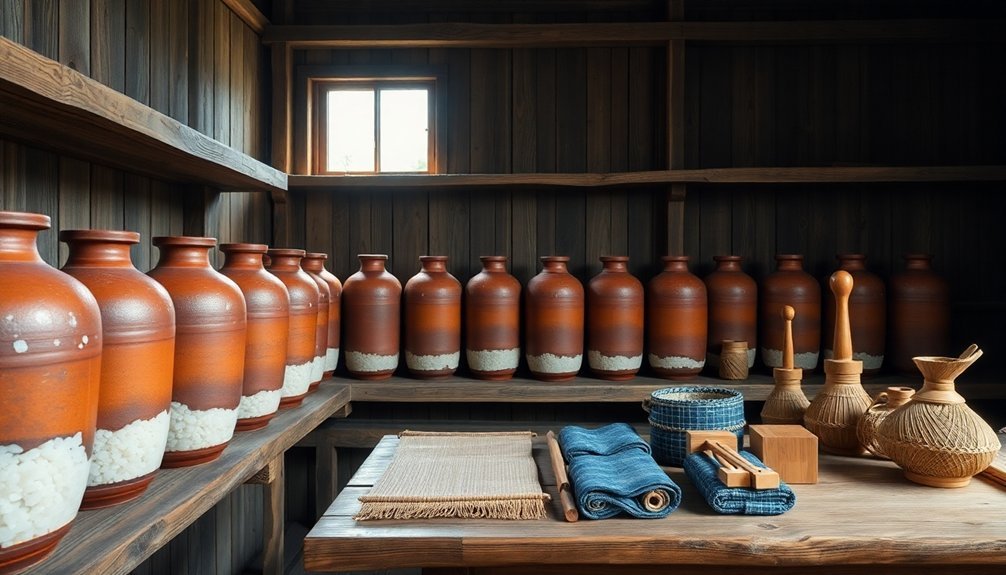
The rich history of Japanese preservation vessels dates back to the Kofun Period when anagama kilns first emerged on the hillsides of Japan.
These roofed-tunnel kilns, introduced from Korea in the 3rd-4th centuries AD, revolutionized pottery production by achieving temperatures over 1,200°C, creating incredibly durable stoneware perfect for preservation.
You'll find that traditional Japanese preservation vessels were crafted through various specialized techniques and styles, each serving specific purposes.
The "Six Old Kilns," including renowned centers like Seto and Shigaraki, developed distinctive approaches to vessel creation, with Seto becoming particularly famous for its glazed ceramics after 1223.
- Unglazed stoneware vessels were essential for heavy-duty storage of rice, grains, and fermented foods.
- Seto ware offered versatile glazing options, including ash brown and iron black finishes.
- Regional kilns utilized local materials, creating unique characteristics in their preservation vessels.
- High-temperature firing in anagama kilns produced distinctive patterns from reduced-oxygen environments.
These vessels weren't just functional items; they represented a perfect blend of utility and craftsmanship, serving both daily storage needs and ceremonial purposes in Buddhist rituals and tea ceremonies.
Sake Chemical Properties
Modern sake production builds upon centuries of preservation knowledge, transforming simple ingredients into a complex molecular masterpiece. You'll find that sake's chemical composition creates a delicate balance of sugars, acids, and aromatics that naturally preserve the beverage while developing its distinctive character.
The extract contains 10-13g/100ml of residual sugars, while maintaining relatively low acid levels with a pH of 4.2-4.7. You're looking at a carefully controlled fermentation process that produces essential compounds like ethyl acetate and isoamyl acetate, which give sake its fruity and floral notes.
These esters, combined with aldehydes and higher alcohols, create the drink's signature aroma profile.
When you're storing sake, you'll need to take into account its chemical stability. Light exposure and temperature fluctuations can disrupt the delicate balance of compounds, particularly in unpasteurized varieties. That's why you'll want to keep your sake in a cool, dark place.
The presence of sulfur dioxide (0-250 mg/l) helps protect against oxidation, but proper storage remains vital. For opened bottles, refrigeration is your best bet to maintain the intricate chemical harmony that makes sake unique.
Food Pairing Preservation Guidelines
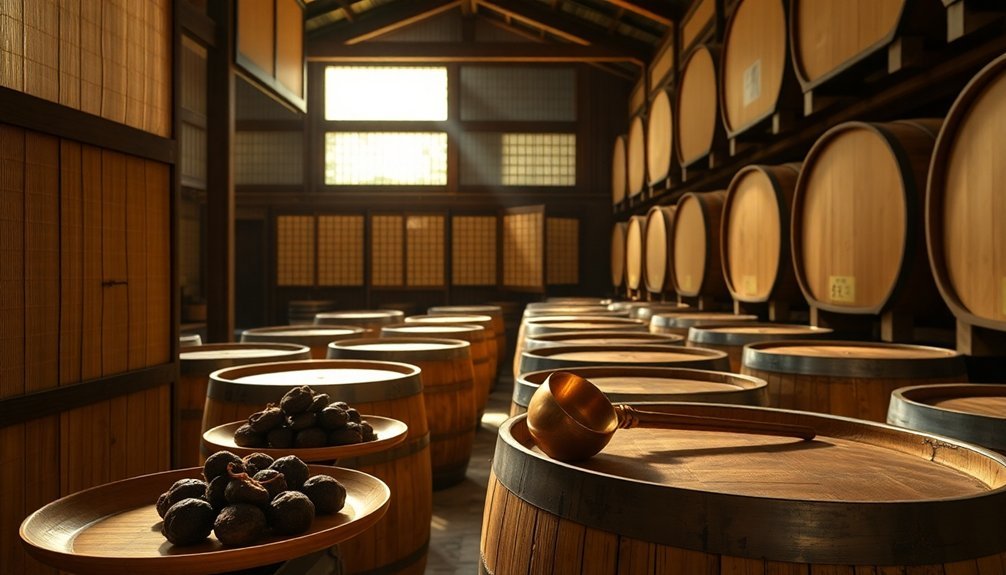
When pairing sake with food, you'll want to store both at ideal temperatures – chilled sake (45-50°F) works best with lighter dishes while room temperature or warm sake (100-105°F) enhances umami-rich foods.
You can match the intensity of sake's umami compounds with similar levels in your dishes, such as pairing rich Junmai with grilled meats or delicate Daiginjo with sashimi.
As sake ages, its flavor profile shifts toward deeper, more complex notes, requiring you to adjust pairings accordingly by selecting heartier dishes that can stand up to the increased intensity.
Storage Temperature With Foods
Preserving sake alongside food pairings requires careful attention to temperature control, as both the sake and its accompanying dishes benefit from proper storage conditions.
You'll want to maintain temperatures below 12°C (54°F) for your sake storage area, with an ideal range falling below 8°C (46°F) for more delicate varieties like unpasteurized nama-zake and ginjo styles.
When storing sake with food pairings, keep these temperature guidelines in mind:
- Store delicate sakes (daiginjo, ginjo, nama) at refrigerated temperatures around 5-8°C (41-46°F) to maintain their subtle flavors and prevent spoilage.
- Keep fuller-bodied sakes at cool cellar temperatures of 10-12°C (50-54°F) to preserve their rich character.
- Position bottles upright in dark storage conditions to minimize oxygen contact and light exposure.
- Adjust serving temperatures based on the sake style and food pairing, ranging from chilled (5-15°C) to room temperature (15-18°C).
Remember that heat can damage both sake and food, causing off-flavors and premature spoilage.
Once you've opened a bottle, consume delicate varieties within days and fuller-bodied types within a month while maintaining proper storage temperatures.
Umami Flavor Matching Guide
Understanding umami flavor pairings elevates your sake experience while maximizing the preservation of both drink and dish. You'll find that combining glutamate-rich foods with those containing nucleotides creates a powerful umami synergy that enhances preservation methods.
| Food Type | Sake Style | Preservation Method |
|---|---|---|
| Fresh Fish & Shellfish | Light, Floral Sake | Salt-Curing + Citrus |
| Aged Cheese & Cured Meats | Rich, Bold Sake | Wax Coating + Cool Storage |
| Mushrooms & Seafood | Grain-Forward Sake | Drying + Vacuum Sealing |
| Miso & Soy Dishes | Herbal, Spiced Sake | Fermentation + Aging |
When you're matching sake with preserved foods, consider the balance of five key tastes. Pair salty preserved meats with low-acid sake to maintain flavor integrity. For sweet-preserved items like honey-glazed fish, opt for sweeter sake varieties. You'll want to balance sour pickled vegetables with robust sake types, while bitter preserved greens pair well with miso-influenced sake. Remember that temperature control remains essential – store both sake and preserved foods between 55-65°F (13-18°C) for ideal flavor retention and preservation duration.
Aging Effects on Pairings
Through aging, sake transforms its pairing potential in predictable ways that affect long-term food preservation strategies. When you're aging sake at higher temperatures in large tanks, you'll get bolder flavors that pair exceptionally well with preserved foods like cured meats and aged cheeses. Conversely, cold-aging in bottles creates subtler changes that complement delicate preserved items such as pickled vegetables.
- Tank-aged sake at room temperature develops rich umami notes that enhance long-preserved fish dishes, particularly dried tuna and salted mackerel.
- Bottle-aged sake at cold temperatures maintains its delicate character, making it suitable for lightly preserved foods like quick-pickled vegetables.
- Hybrid-aged sake (tank followed by bottle) offers versatility in pairing with both robust and subtle preserved foods.
- Premium grades like ginjo-shu, when aged, retain their refined qualities while developing complexity that pairs well with specialty preserved items.
You'll find that aging method directly impacts preservation-friendly pairings. For best results, match your aging approach to your preservation needs: use tank-aged sake for heavily preserved foods and cold-aged sake for lighter preservation methods.
The temperature at which you serve your aged sake can further fine-tune these preservation-focused pairings.
Modern Sake Storage Solutions
Modern sake storage technology has revolutionized how we maintain this delicate beverage's quality.
You'll find that temperature control is vital, with ideal storage conditions ranging between 5-15°C. For peak preservation, you can store your sake at temperatures as low as -5°C, which greatly reduces deterioration and preserves the flavor profile.
To protect your sake from harmful light exposure, you'll need to shield it from both direct sunlight and UV rays. You can wrap bottles in opaque materials or use tinted bottles, and you should always store them in a dark location.
When you're using a refrigerator, minimize exposure to interior lighting.
You'll want to keep your sake bottles upright to prevent unnecessary contact with the cap and maintain sediment at the bottom. After opening, it's important to seal the bottle tightly and store it in the refrigerator. For enhanced preservation, you can use a vacuum sealer to protect against oxidation.
Consider investing in specialized storage solutions like a dedicated sake fridge or the SAKE CABINET, which offers precise temperature control and proper upright storage.
These modern solutions guarantee your sake maintains its quality and distinctive characteristics longer.
Sake Brewing Process
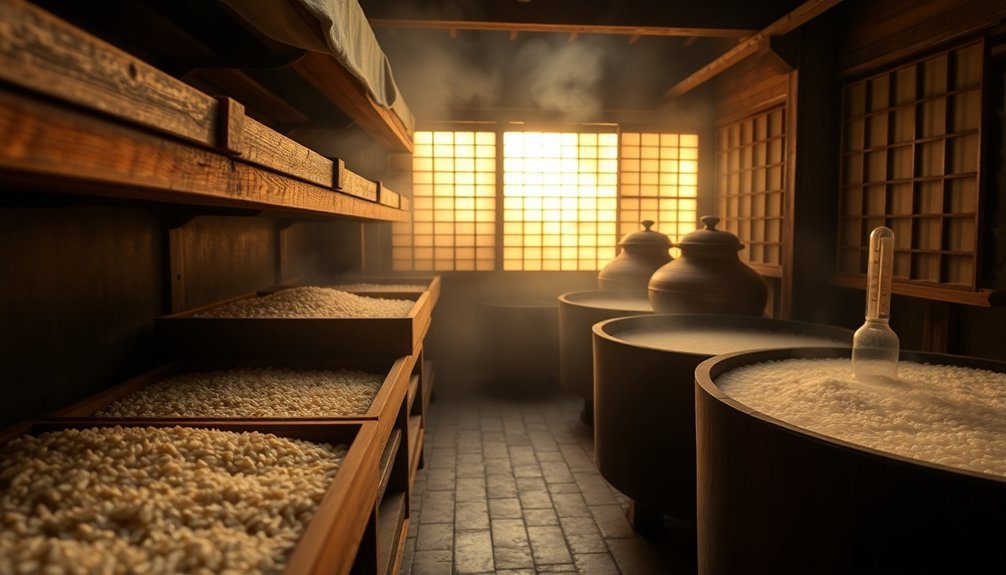
The sake-making journey begins with precisely prepared rice, the foundation of this revered Japanese beverage. You'll find that sake rice undergoes extensive polishing to expose its starchy core, followed by thorough washing and soaking to achieve ideal moisture content. The rice is then steamed for up to an hour before cooling.
The heart of sake brewing lies in the creation of koji and starter mash. You'll witness the careful cultivation of koji mold on steamed rice under controlled conditions, which then combines with yeast to form the essential starter mash called shubo.
- The main fermentation follows the traditional sanzan jikomi method.
- Multiple parallel fermentation occurs as koji converts starches to sugars.
- Temperature and environment remain precisely controlled for 20-30 days.
- Fermentation continues until alcohol content reaches 16-18%.
Once fermentation completes, you'll see the sake undergo pressing to separate it from the lees, followed by filtration and pasteurization.
The process concludes with a six-month maturation period in tanks, where the sake develops its refined character before being diluted to achieve the desired alcohol content.
Japanese Food Storage Wisdom
Japanese households have preserved their culinary heritage through time-tested storage methods dating back to the Jomon period. You'll find that fermentation has remained a cornerstone of preservation, using seaweed-derived salt, koji starter, and brine mixtures to maintain food freshness.
| Method | Ingredients Used | Benefits |
|---|---|---|
| Traditional Fermentation | Sake, vinegar, miso, salt | Creates vitamins, antioxidants; improves digestion |
| Tsukemono Making | Seasonal vegetables, salt, brine | Provides probiotics, fiber, vitamins |
| Koji Processing | Rice, soybeans, salt | Enables mass production of sake, soy sauce |
| Modern Retort | High-pressure heating | Long shelf life without preservatives |
Today, you can blend traditional and modern preservation techniques in your kitchen. While retort foods offer convenience for busy lifestyles, traditional methods like tsukemono-making still connect communities through morning pickle markets. You'll notice these preservation methods aren't just about longevity – they're about enhancing nutrients and flavors. By breaking down antinutrients, fermentation makes seeds, nuts, and grains more digestible while creating beneficial compounds that can lower blood pressure and reduce inflammation.
Seasonal Preservation Methods
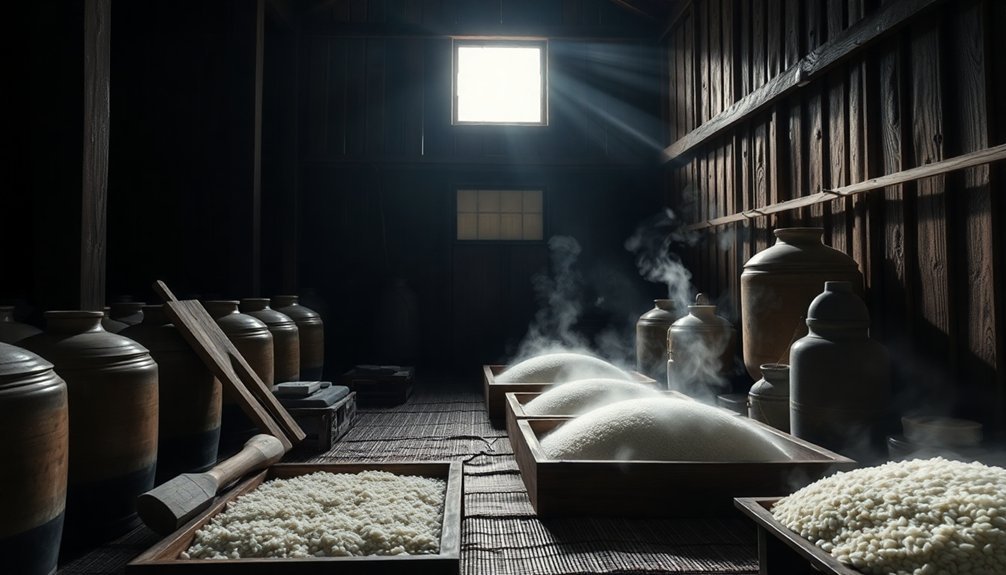
Traditionally, seasonal preservation methods in Japan follow nature's rhythms, with communities collecting wild vegetables from spring through early summer for winter storage.
You'll find various techniques being used to guarantee food availability throughout the year, particularly in regions isolated by deep snow and high mountains.
- During spring and early summer, you'll witness locals gathering mountain vegetables and preserving them in large salt-filled barrels, guaranteeing sustenance during harsh winters.
- You can see the ingenious use of yukimuro (snow rooms) and yukiana (ice houses), where the natural snow cover maintains ideal humidity and temperature for preserving raw fish and vegetables.
- You'll discover how radishes retain their sweetness when stored in snow until spring, showcasing nature's role in food preservation.
- You'll encounter traditional fermentation methods, including tsukena (nozawana pickles) that transform into nīna through a process of fermentation and boiling.
These preservation techniques rely heavily on natural elements and time-tested methods like salting, pickling, and fermenting.
The practice isn't just about food storage; it's a self-sufficient system that's deeply woven into the cultural fabric of Japanese communities.
Frequently Asked Questions
Can Sake Be Used as a Natural Preservative for Fruits and Vegetables?
You can use sake as a natural preservative for fruits and vegetables. It'll kill bacteria, prevent spoilage, and maintain freshness. When combined with salt or vinegar, it'll help preserve flavor and texture effectively.
Does the Alcohol Content in Sake Affect Its Ability to Preserve Food?
While sake's alcohol content (15-17%) can help inhibit some bacterial growth, it's not high enough to be an effective preservative on its own. You'll need additional preservation methods to safely store foods long-term.
What Traditional Japanese Herbs Were Combined With Sake for Preservation Purposes?
You'll find that Japanese traditionally combined fennel, lavender, and Queen Anne's Lace with sake for preservation. They also used peach blossoms, cherry blossoms, and rugosa rose to enhance both flavor and shelf life.
How Did Ancient Sake Masters Determine Optimal Preservation Ratios for Different Foods?
You'll find ancient sake masters used trial-and-error testing, observing food spoilage rates and conducting taste experiments. They'd record successful preservation ratios in detailed brewing journals, passing this knowledge through generations of brewers.
Can Sake-Preserved Foods Be Consumed Safely by Children and Pregnant Women?
You shouldn't give sake-preserved foods to children or pregnant women. The alcohol content poses health risks even in preserved foods. It's best to choose alternative preservation methods that don't involve alcoholic ingredients.
In Summary
You'll find that traditional Japanese sake preservation methods remain relevant even today. Whether you're storing sake itself or using it to cure foods, these time-tested techniques offer valuable lessons in temperature control, light protection, and seasonal awareness. By applying this ancient wisdom to modern storage solutions, you're not just preserving food – you're keeping alive centuries-old practices that have proven their worth across generations.

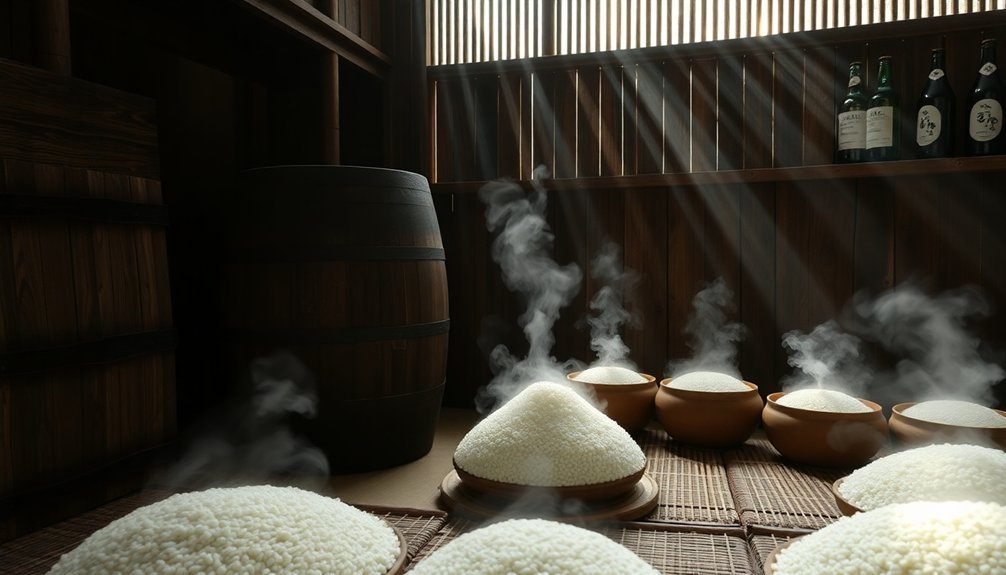



Leave a Reply